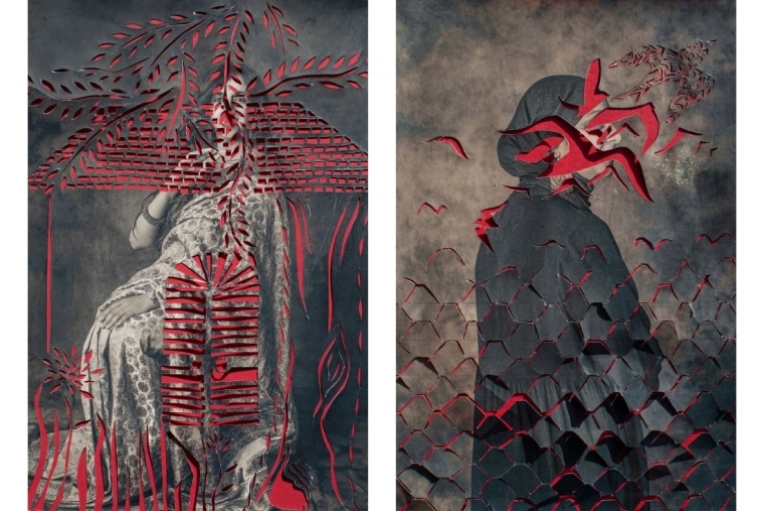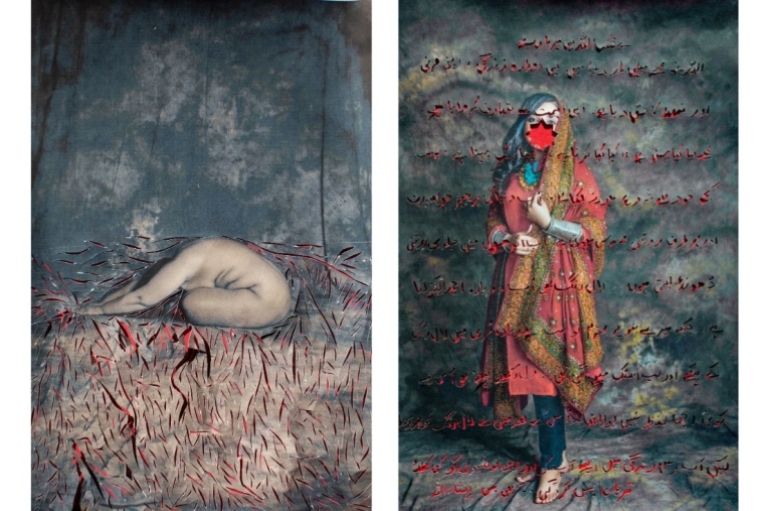
Circles in Sand (left) | The premise of my existence (right)

Circles in Sand (left) | The premise of my existence (right)
At the intersection of personal experience and artistic expression, British Indian photographer Sujata Setia has created a body of work that dares to look at the most painful, silenced parts of society. Her project A Thousand Cuts, showcased at the Madras Art Weekend, reinterprets the metaphor of Lingchi, an ancient Chinese form of torture known as 'death by a thousand cuts,' to reflect the cyclical nature of domestic abuse. With intricate portraits that speak to the lived experiences of South Asian survivors, Setia has gone beyond photography to create a visceral art form that speaks to the fragility of existence, the scars of trauma, and the possibility of healing.
The Birth of A Thousand Cuts
The idea behind A Thousand Cuts is deeply personal. Sujata, who grew up in an environment marked by domestic violence, wanted to create work that would reflect the stories of survival and the complexities of abuse. “Domestic abuse has sort of become one large event, and nobody’s individual voices are heard under it,' she says. 'That is a very deep kind of silencing.' Her aim was always to focus on these individual stories, bringing them out of the shadows.
She began working on the project in 2020, following the passing of her mother. The process started by reaching out to SheWise UK, a charity that supports South Asian survivors of domestic violence in the UK. She had no clear visual representation in mind at the time. “I knew that the survivors would not want their identities to be revealed, and I had to respect that,' she explains. “I told them this was pure experimentation. The first step would be just having conversations and seeing how it goes from there.'
The survivors she worked with came from a variety of backgrounds, some living in refuge spaces, others still in abusive relationships. But in each case, she created a safe, open space for dialogue. 'We literally sat down and had conversations. The only rule was that nobody would interrupt or judge the other person. We cried, shared trauma, and held hands,' she recalls.
The interviews were an emotional experience. Many survivors, after sharing their stories, decided not to move forward with the project. 'They said, We’ve left our story behind in this room, and we don’t want to return to it anymore. I respected that,' she says. For those who chose to participate, the conversations became the foundation of the photographic work that would follow.

Sujata Setia
Photography as a Means of Finding Voice
Sujata's journey into photography began as a way to reclaim her own voice. 'I was a journalist in India, and I moved to the UK after marriage. I didn’t find a job and fell into a deep depression,' she explains. 'My camera became my language. It allowed me to bond with my daughter, who was born during that time. It was a way to express myself when I felt completely silenced.'
Photography became her means of making sense of her own life, and through her lens, she found a way to document the trauma and survival of others. 'For me, the camera was a way to understand my relationship with my daughter, and also break the cycle of abuse I had inherited,' she says. 'It gave me a new sense of purpose.'

How many more Knots (left) | God’s Cow (right)
The Metaphor of Lingchi and Domestic Abuse
Lingchi, or 'death by a thousand cuts,' is an ancient form of torture in which a victim is slowly and repeatedly wounded in small, seemingly insignificant ways until death. Her choice to use this metaphor is both powerful and poignant. 'The idea behind the work is that the victim of abuse is being slowly and steadily destroyed. It’s not one big event but a series of cuts—emotional, physical, sexual—that build up over time,' she explains. 'And just like Lingchi, the victim doesn’t always realize the pain until it’s too late. It becomes normalized in their mind.'
This metaphor is reflected in the patterns she uses in her portraits. She chose to incorporate the Indian art form of sanjhi, or paper cutting, as a way to symbolically 'cut' into the faces of her subjects. In traditional sanjhi art, the cuts are made to appease the male figure—often Krishna—demonstrating the gender roles within South Asian culture, where women are expected to 'appease' and men are 'appeased.' She uses these cuts as a way to visually represent the violence and control embedded in these dynamics.

Prisoner of the prison (left) | Pinion (right)
The Role of Color: Red as a Symbol of Strength and Renewal
Sujata also used color to add depth and meaning to the work. The most striking color in the series is red, a color with deep cultural significance in South Asia. 'Red is the color of marriage, the color of death, of suffering, of love, and of strength,' she explains. 'It’s the color of a woman’s vermillion, her bindi, and even the color of her wounds. But it’s also the color of new beginnings. It signifies transformation.'
For her, red symbolizes both the violence that the survivors have endured and the possibility of healing. 'The color red is also seen in countries with foggy climates, like Scandinavia, where buses are painted red because it’s the only color visible through fog. It’s a sign of hope, of something shining through even in the darkest of times,' she says. 'I wanted to show that these scars are not just wounds—they are also the beginning of a new version of you.'
The black-and-white nature of the portraits adds another layer of depth to the work. She says, 'The black-and-white aesthetic is intentional. It’s vintage, a reminder of a time when the survivors' choices were not their own. Their lives were decided for them by society, family, or culture. At the same time, it celebrates who they are now, after surviving.'

Statue (left) | Unconfined or Unhinged (right)

A place to call home (left) | Fenced Flight (right)
Creating a Space for Healing
One of the unique challenges of this project was that Sujata wanted to build trust with the survivors, so they would feel comfortable expressing themselves visually. After hours of deep conversation, she began photographing the survivors in locations that were convenient and safe for them—often outdoor spaces, like children’s parks, where they could feel a sense of freedom.
But her initial visual concept was far more abstract, rooted in the symbolism of a white sheet in South Asian culture. 'The white sheet is central to a South Asian woman’s life,' she explains. 'It’s there from birth, when the baby is wrapped in it and given to the parents. It’s also the cloth that represents modesty, whether in the form of a dupatta, hijab, or head covering.' She also considered how the white sheet plays a role in defining a woman’s virginity and purity on the wedding night. However, she soon realized that the survivor’s voices must come first, so she shifted her approach to include their input.
As she sat with the survivors and listened to their stories, the idea of 'death by a thousand cuts' emerged as a metaphor. 'I had to find a way to visually represent that deep-rooted, cyclical nature of domestic abuse,' Setia says. 'The survivor gets chipped away at bit by bit, until the pain becomes so normalized that they stop recognizing it. It’s as if the cuts become part of them.'

Culture Death (left) | Finding Me (right)
Words Paridhi Badgotri
Date 16.12.2024